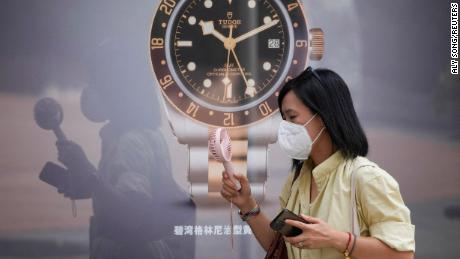
Graphic shows all the changes in global temperature since 1850
Hong Kong (CNN Business)A scorching heat wave in China has forced a major manufacturing region to appeal to businesses and households to use less power, while fear of crop failure is sending pork prices soaring.
Dozens of cities have been experiencing record-high temperatures at a time when the economy is still trying to recover from bruising Covid-related lockdowns. The heatwave also comes as consumer inflation hits a 23-month high, mainly driven by rising food prices.
As many as 84 cities across the country on Wednesday issued their highest-level red alert warnings — which means temperatures are expected to reach over 40 degrees Celsius (104 Fahrenheit) in the coming 24 hours — according to the National Meteorological Administration. Shanghai reported 40 degrees Celsius on Sunday for the first time this year.
China’s heat wave has pushed electricity demand to extreme levels in many regions as people turn up the air conditioning.
On Tuesday, Zhejiang province — a major export and manufacturing powerhouse on the east coast — urged its 65 million residents and businesses to save power.
“In order to ensure electricity supply for residents and companies …we call for the joint actions by the whole of society to save electricity,” the province’s energy bureau and the State Grid said in a joint statement.
Zhejiang’s energy bureau has also rationed supply of power for some energy-intensive firms, such as polyester producers and textile printing and dying companies in the cities of Hangzhou, Shaoxing, and Haining, according to analysts from several Chinese brokerage firms.
The latest shortages come just months after China emerged from an energy crisis that caused widespread power outages in the second half of last year. The blackouts were blamed on shortages of coal, which China uses to produce about 60% of its electricity, and a surge in power demand.
The current heatwave and resulting power-rationing presents yet another challenge for China’s massive manufacturing industry, which is still recovering from months of strict Covid lockdowns.
China publishes GDP data for the April-June quarter on Friday and it’s expected to show growth slumping to around 1% in the second quarter from 4.8% in the first three months of the year.
Inflation worries
High temperatures are also hitting China’s crop production, threatening to push up food inflation.
The Central Meteorological Observatory has warned that high temperature could adversely impact the production of corn, soybean, wheat, and pastures in many northern provinces, such as Ningxia, Inner Mongolia, and Hebei.
Rising food prices in both domestic and global markets have started impacting the feed industry and pig farming in recent weeks.
Earlier this month, a number of major feed producers, including New Hope Group, warned clients that they would increase prices of pig, poultry and fish feeds because of rising cost of soybean meal, corn and wheat. Most of the price hikes kicked in last week.
Pork, the staple meat in China, has been particularly badly affected, as soybean and corn are the main ingredients used in the pig industry.
By the week ending July 1, hog prices had increased 46% since March, according to the most recent data from the National Development and Reform Commission, the country’s top economic planner.
The commission said last week it was considering tapping the country’s strategic pork reserves to contain the rapid increase in prices. It also pledged to clamp down on any price gouging behavior by pig farms.
According to China’s most recent CPI data, the consumer price index increased 2.5% from a year earlier, up from 2.1% in May and the highest in nearly two years. Pork prices, which rose nearly 3% in June from May, had added to the upward pressure, the national bureau of statistics said in a statement.
— CNN’s Jessie Yeung and Shawn Deng contributed to the reporting.
Source: Read Full Article


